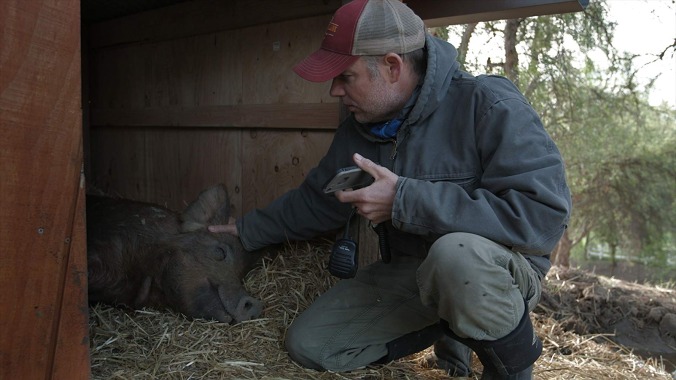The Biggest Little Farm is a simplified, PR-friendly look at an agricultural triumph


John and Molly Chester’s entire life changed when they adopted Todd, their beloved rescue dog. After his incessant barking forced them to move out of their small Santa Monica apartment, the couple decided to fulfill their dream of starting a “traditional farm,” one driven by regenerative agricultural practices that emulate how natural, bio-diverse ecosystems function. In 2011, the Chesters bought 200 acres of neglected land in Moorpark, California and, with the help of mentor and guru Alan York, spent the past eight years building it up from scratch. They committed to working in harmony with nature, as opposed to intervening against it, to create a self-perpetuating environmental network. Apricot Lane Farms, they called it.
A broadly crowd-pleasing documentary, The Biggest Little Farm chronicles the Chesters’ journey from city-dwellers to farming professionals, capturing the myriad obstacles they faced along the way. They learn about the threats that endanger their farm’s survival, from typical pests—coyotes, gophers, snails, etc.—to unpredictable weather patterns, like a “wind season” and, more pertinently, California’s historic drought this past decade. Additionally, they contend with the practical difficulties of living alongside many animals, including Emma the pregnant pig and Greasy the rooster, each with their own specific needs. Though the Chesters’ idealism is quickly complicated by fickle nature, their perseverance never falters.
While Apricot Lane Farm’s origin story is plenty compelling, there’s an often insurmountable gap between the film’s form and content. In short, John Chester, who directed The Biggest Little Farm himself, doesn’t trust the audience to become invested in his story. Though John might best have utilized his folksy-preacher voiceover to explain specific farming processes, he mostly employs it to jab the audience in the ribs with faux-profound insights or to telegraph obvious plot beats. His background as a wildlife cinematographer is evident in the farm footage, which ranges from home-movie vérité to slickly traditional nature doc (complete with time-lapse sequences). But none of it has much impact because it’s so narratively streamlined: The imagery is little more than a visual aid to the Chesters’ story. The saccharine score all but spells out how the audience is supposed to feel every single step of the way, and the less said about the precious animated sequences in the first act the better.
There’s a more potentially complicated and fascinating film in the material the Chesters choose to elide. The Biggest Little Farm brushes aside the financial burden of starting and sustaining a small biodynamic farm with the quick mention of mystery investors “who saw this old way of farming as the future.” Little attention is paid to Apricot Lane’s business realities, especially during the period when pests were decimating 70% of their fruit yield, or how the Chesters’ ideological experiment fares in a competitive marketplace. It’s possible that including such dry elements would distract from the “inspirational” story. It would also likely soften The Biggest Little Farm’s potential as a marketing campaign for Apricot Lane Farms—a function the Chesters dance around and then lean into heavily by the end. In case you couldn’t guess, the film closes with a URL where “the story continues.”
Most egregious is the Chesters’ choice to entirely ignore the specter of climate change and how it would impact their farm’s long-term sustainability. The Biggest Little Farm champions bio-diversity and restorative practices, but for all of its talk about the complexity of nature, it seems entirely disinterested in the tempestuous machinations of the surrounding climate. Chester bookends his film with menacing footage of the 2018 California wildfires, which were right on the cusp of affecting Apricot Lanes. Instead of even mentioning the root causes of such an event, the film shrugs it off with a grateful acknowledgment of the changing winds (“If we’ve learned anything, forward momentum and hope, that’s what nurtures luck…”). Again, somber talk of the climate apocalypse might divert attention from the shots of cute animals, or upset the publicity dimension, or run counter to the film’s solutions-first agenda. But given the subject matter, it’s disingenuous not to confront the issue at all.
While advocacy documentaries have never needed strong visual sense to make their point heard (see: An Inconvenient Truth) it’s frustrating that so many don’t use the medium more effectively. Non-fiction filmmaking isn’t merely a vehicle for narrative storytelling or stealth advertising; it’s an art form with its own language. And it’s not like those disinterested in learning that language don’t have other avenues—books, articles, blogs—for exploring a topic in depth. The Biggest Little Farm has many valuable points to make about the connection between how our food is grown and eco-friendly living, but style betrays substance so often here that the message gets lost in the shuffle. Unless that message is simply We Bought A Farm!